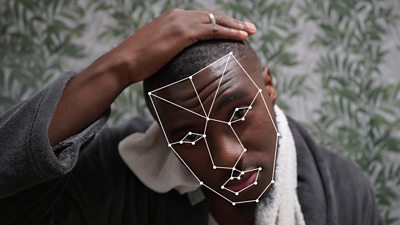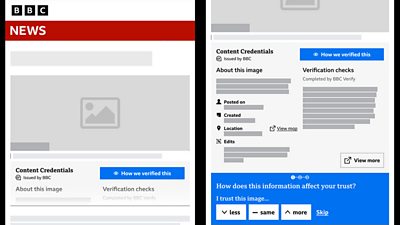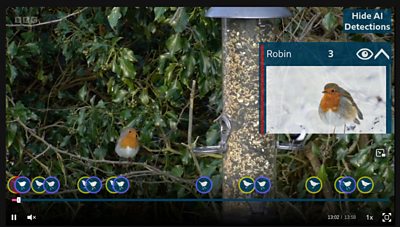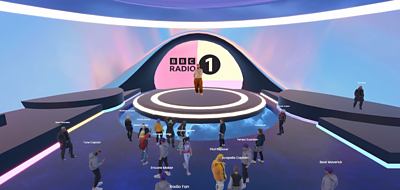BBC Research & Development has always been adept at predicting how the technology landscape will develop. We look at trends across society, audience behaviour, and technology to identify if, whether, and how the BBC might respond.
When we see a need to respond, our remit is to explore and develop media technologies that speak to the opportunities and risks these trends present. What’s different about us is that as a public service media organisation, whatever we create must be responsible, ethical and for the good of the BBC, licence fee payers, the media industry, and society.
Technology and innovation has always been at the heart of the BBC, (article 15 of the Royal Charter asks the BBC to "ensure that it conducts research and development activities geared to the fulfilment of the Mission and the promotion of the Public Purposes"), and it is essential that this continues to ensure that we remain independent, sustainable, and responsive to future challenges and opportunities.
We have now begun a new cycle of work which, as always, uses a public service lens to consider the forces we expect to shape the media landscape for a generation.
In this article, I’ll point to these forces, outline three hypotheses for how we think the technology landscape will develop, and explain the framework we use to decide what research to conduct and in what direction.

For well over a decade, we have been researching and developing technologies to prepare the BBC for a time when the majority of our content and services will ‘live’ online. Distributing content at a speed to rival broadcast, using 5G networks for contribution, developing cloud-based media content delivery and stores, and creating interactive, personalised and immersive experiences. These are just some of the ways we use internet technology to help the BBC to navigate and thrive through this transition.
R&D’s vision is to enable audiences and the BBC to thrive in an increasingly internet-only, AI enhanced, hyper-competitive future.
Of course, as a public service broadcaster, it is essential that our services are universally available and that we do not leave anyone behind as part of the transition from traditional broadcast to internet technology. Our director general Tim Davie has stated that we will use both types of technology to serve audiences for as long as is necessary.
However, our job in R&D is to look beyond this time, and our work over the last few years has become about more than just preparing the BBC for that transition.
For example, the rate of development of artificial intelligence (AI) and the speed at which it is already part of our lives is unprecedented and will only increase. As technology forecasters, we’ve already done a lot of work in this area, but in our new research cycle, we need to explore the use of AI more fully to ensure that how the BBC uses this technology is always responsible, ethical and in the public interest.

As BBC R&D’s director, I’m privileged to work with the world’s best media engineers and technologists. We have leading domain experts in our department and we are plugged into global networks of people and organisations such as the European Broadcasting Union, The World Wide Web Consortium, Partnership on AI, the International Telecommunications Union and the Coalition for Content Provenance and Authenticity; who, like us, are actively developing technologies that will shape the future.
Exposure to these experts and networks, and observing the impact of things like social and political contexts, climate change, and consumer behaviour can inspire deep thinking. For me, it provides clarity of thought about what we should focus on.
Three hypotheses are central to our current thinking:
1. All user interaction will be driven by artificial intelligence.
As AI technologies continue to develop, they will drive personalised and contextualised user interactions across news and media platforms. From content recommendations to real-time language translation and automated story generation, AI will become central to shaping the user experience. This transformation will not only enhance audience interest but also enable platforms to better understand audience preferences and adapt their content strategies accordingly.
In a world where competition for audience attention is spread among an increasing number of players, AI-driven interaction will allow for hyper-personalised content delivery, improved user retention, and optimised marketing strategies, ensuring relevance and long-term viability.
This presents a challenge for the BBC. Over many decades, we have built and maintained trust with audiences worldwide through our impartial journalism. Business models are changing and pushing industries to transform. As this AI ecosystem evolves, we will need to define an approach that ensures we can maintain and build on the trust we have in this new environment.
2. The internet backbone will feature a new layer that provides a permanent and transparent registry for digital assets.
This hypothesis envisions using distributed ledger technologies (like those that underpin blockchains), to create a new layer of core internet infrastructure that provides secure and tamper-proof tracking of digital content and assets. For the news and media industries, such a layer can help fight disinformation by verifying the authenticity of articles, images, and videos while ensuring appropriate attribution and rights management for creators.
Tackling misinformation, content piracy, and copyright infringements are key challenges for our industries. This new layer of internet infrastructure would promote greater transparency and trust, empowering both creators and consumers while fostering a more credible media ecosystem.
3. Artificial intelligence infrastructure will be treated as national critical infrastructure.
With AI driving major advancements across industries, the underlying infrastructure—such as data centres, training models, and computational resources—will be recognised as vital to national security and economic stability. Governments and private entities will prioritise its development, protection, and governance, much like how utilities such as electricity or telecommunications are managed.
For the media industry, robust AI infrastructure will ensure the seamless operation of tools used to generate, curate, and distribute content. It would also guarantee resilience against cyber-attacks targeting AI systems and uphold the reliability of AI-driven journalism during critical events, such as wars or elections.
These hypotheses highlight the transformative potential of emerging technologies in shaping the future of news and media. By focusing on AI-driven user experiences, ensuring transparency in digital asset management, and recognising the strategic importance of AI infrastructure, media organisations can adapt to a rapidly evolving technological and societal landscape while maintaining relevance and trust.
Once we had these hypotheses, we had to work out how the themes might impact the BBC, how they relate to our remit and how we can contribute to any associated technological development and direction.
An introduction to the 5i's
We don’t assume that any single technology will define the media ecosystem of the future. Instead, we believe that it will reflect a set of characteristics - or outcomes - enabled by different types of technologies.

This led us to come up with the 5is framework that helps us to envision a media landscape that is increasingly:
- Internet-only – produced and distributed by Internet Protocol or IP.
- Intelligent – enhanced and automated by AI.
- Intermediated – mediated by platforms and agents.
- Interactive – optimised for user experience, engagement and advertising.
- Immersive – augmented by immersion and contextual awareness.
This framework doesn’t just look at our work, but takes in the world in which we exist, and for others in the industry. Advertising, for example, is part of that, so it will influence the direction some technologies take.
Internet-only
- Produced and distributed by IP

More than half of UK households will exclusively watch TV over the internet by 2030
The next generation of audiences will consume BBC content over IP. In time, the BBC itself will also likely become a primarily internet based organisation. We are exploring how we make this an equitable digital transition for all - to ensure that the future of media provision is sustainable, affordable and universal and that the organisation is positioned to create and distribute content in ways audiences want.
Using advances in internet technology, we aim to create new audience experiences for everyone regardless of location and socioeconomic status.
If you’ve ever streamed a live programme over the internet while someone else nearby is watching the same thing on broadcast television, you’ll know that the streamed version is usually a bit behind. Our low latency research has significantly reduced the delay from internet streamed content.
Intelligent
– Enhanced and automated by AI

57% of UK Millennials want their content hyper-personalised
As AI develops, we want to ensure that it benefits the creative industries and society by leading the development of foundational capabilities and models that serve people, industry, and the UK.
We want the AI used by the BBC to make us better, more accountable, and responsive to audiences both national and local.
We want to develop AI technology that has been trained ethically and responsibly and will enhance the output that our journalists and production colleagues create.
R&D is integral to the BBC’s work to investigate how AI, specifically Generative AI, could be used within the organisation and our research adheres to three principles set out by the BBC’s AI leader, director of nations, Rhodri Talfan Davies:
- always act in the best interests of the public,
- always prioritise talent and creativity,
- always be open and transparent with audiences when we use AI to support content-making.
Intermediated
– Mediated by platforms and agents

Over 50% of UK adults use social media as a news source
To maintain a direct, independent relationship with audiences, we need to understand and work with the platforms and agents that sit between us and them. We are developing mechanisms for engaging with audiences wherever they are, however they connect.
The BBC has collaborated with other broadcasters to develop Freely, a free streaming service that offers live and on-demand TV. Our work has contributed to the development of open standards, which make it easier to participate in the creation of new technologies.
In 2019, a consortium called Coalition for Content Provenance and Authenticity, or C2PA, was co-founded by BBC R&D alongside other members, including Adobe and Microsoft. Since then, C2PA has developed a technical standard to encode information about the provenance of imagery, video, and audio — information (or signals) that show where a piece of media has come from, and how it’s been edited. Similar to an audit trail or a history, these signals are called 'content credentials'.
Interactive
- Optimised for user experience & engagement

Interactive content generates a 52% higher engagement rate than static content
Audiences today demand more than passive consumption, they seek interactive experiences that allow them to engage with content, creators, and communities in real time. We are at the forefront of this shift, developing technologies that enhance audience interactivity while supporting the UK’s creator economy. By enabling new forms of engagement, we aim to drive deeper connections and unlock innovative storytelling opportunities.
Immersive
- Augmented by immersion & contextual awareness

By 2025, it’s predicted that the UK population will reach 68.3 million, and that 95% (roughly 65 million people) will be smartphone users
With our audience increasingly connected, we want to offer immersive experiences, contextual awareness, and enhanced interaction with our content and services across all internet connected devices. We are exploring how we can create new audience experiences defined through a public service lens.
We have a cohesive vision of the future - fit for a generation, with a long-term research agenda, facilitated by the 5is framework that supports that this vision.
Our work will take advantage of technological advancements, using them to inspire and enhance BBC products, services, and operational efficiency.
Our work is built to public service values that prioritise universality, inclusivity, accountability quality, resilience, sustainability, efficiency, and scale.
And I’m proud to be a part of it.
More of our work on:
- Internet - IP and cloud production and broadcast, streaming, mobile
- Intelligence - Artificial intelligence, machine learning, generative AI
- Immersion - Virtual, augmented, mixed realities, 360˚ video, metaverse, immersive worlds
- Immersion - Next generation audio, binaural sound
- Interactivity - Audiences, new content, new experiences
Search by Tag:
- Tagged with Internet Internet
- Tagged with Artificial Intelligence and Machine Learning Artificial Intelligence and Machine Learning
- Tagged with Distribution Distribution
- Tagged with Immersion Immersion
- Tagged with Interactivity Interactivity
- Tagged with Automation Automation
- Tagged with Content Formats Content Formats
- Tagged with Personalisation Personalisation
- Tagged with Networks Networks
- Tagged with IP Production and Broadcast IP Production and Broadcast
- Tagged with Devices Devices
- Tagged with Features Features

